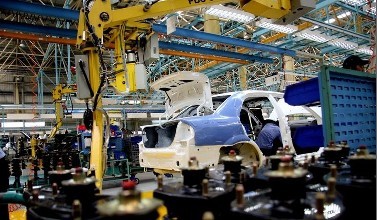- 模板介绍
- 下载记录
- 用户评价
参考译文见下期。
上期机动车运行安全技术条件》参考译文:
Excerpt
Safety specification for power-driven vehicles operating on roads
1. Scope
This standard specifies the basic technical requirements and testing methods for complete vehicle and its main assemblies, safety protection equipment of power driven vehicle on the aspect of operation safety. This standard also specifies additional requirements for fire fighting vehicle, ambulance, engineering emergency service vehicle,police vehicle and automobiles specially for disabilities. .
This standard applies to all power driven vehicles running on Chinese road. This standard does not apply to electrical trolley vehicles, and wheeled special purpose machinery vehicles designed and manufactured not for driving and using on roads, but mainly for using on sealed roads and fields operation and construction.
Note: Electrical trolley vehicle means road vehicle driven by electrical motor, supplied electricity by erected lines and beared by trails.
2. Normative reference
The following documents are indispensible for the application of this document. For dated references, only the dated edition applies to this document. For undated references, the latest edition of these documents (including all amendments) apply to this document.
GB 1589 Limits of outward dimensions, axle load and masses for road vehicles
GB/T 2408-2008 Plastics----Determination of burning characteristics----Horizontal and Vertical test.
GB/T 3181 Paint film color standard
GB 4094 Motor vehicles—Symbols for controls, indicators and tell-tales
GB 4599 Photometric characteristics of headlamps for motor vehicles
GB 4785 Prescription for installation of external lighting and light-signaling devices for motor vehicles and their trailers
GB 5948 The light distribution performance of motorcycle headlamps
GB 8108 Automotive electric warning devices
GB/T 8196 Safety of Machinery----General requirements for the design and construction of fixed and movable guards.
GB 8410 -2006 Flammability of automotive interior materials
3. Terms and definitions
Following terms and definitions apply to this standard.
3.1 Power-driven vehicle
Any wheeled vehicle which is driven or towed by power devices, operated on road, and intended for the carriage of passengers and/or goods or for special engineering services, including motor vehicle and combination vehicles, motorcycle, tractor towing trailer for transportation, special wheeled machinery vehicle and trailer.
3.2 Motor vehicle
Any power-driven road vehicle which has four or more wheels, which is non-rail, and which is normally used for:
— carrying persons and / or goods;
— towing vehicles used for carrying persons and / or goods;
— special service.
This term includes:
a) vehicles connected to an electric power lines, for example trolley buses;
b) three-wheeled vehicles without cab whose complete vehicle kerb mass exceeds400 kg.
c) three-wheeled vehicles with cab whose complete vehicle kerb mass exceeds600 kg.
3.2.1 Passenger vehicle
A motor vehicle which, on account of its design and manufacture, is intended mainly for carrying persons, including the motor vehicles equipped with special apparatus or appliances but with carrying persons as its main purpose.
3.2.1.1 Passenger car
A motor vehicle which, on account of its design and manufacture, is intended mainly for carrying persons and their luggage and/or occasionally goods, and which has available a maximum of nine seating places, including the driver seat. It may also tow a trailer with center positioned axle.
3.2.1.2 Bus
A motor vehicle which, on account of its design and manufacture, is intended for carrying persons and their luggage, and which has more than nine seating places, including the driving seat.
3.2.1.2.1 Interurban bus
A bus designed and manufactured for transporting passengers between urban cities (urban city and rural area ), and specially used for passenger transportation. It includes sleeping coach, i.e. the bus designed and manufactured to provide sleeping berth to all of its passengers.
3.2.1.2.2 Touring bus
A bus designed and manufactured for tourism, and specially used for carrying tourists.
3.2.1.2.3 Public bus
A bus designed and manufactured to transport passengers in the city. It can be divided into following types according to whether it has passenger standing area:
a) Public bus with passenger standing area. i.e. the bus with a maximum design speed less than70km/h, with seats and passenger standing area, having enough space for passenger on-board and off-board walking during frequent stops. It has fixed route and stops, and is mainly operated in the city built-up area. It includes track-less trolley bus, i.e. the bus driven by electric motor and connected to an electric power lines.
b) Public bus without passenger standing area. i.e. the bus without passenger standing area, having fixed route and stops, and is mainly operated on city roads.
3.2.1. 3 School bus
A passenger vehicle with more that 7 seats and used to pick up preschool infants above 3 years old or students receiving compulsory education to and from their school in organized style.
3.2.1.3.1 School bus for infants
A school bus used for pick up preschool infants above 3 years old to and from their school (kindergarten).
3.2.1.3.2 School bus for primary student
A school bus used for pick up primary students to and from their school.
3.2.1.3.3 School bus for junior middle school student
A school bus used for pick up students receiving 9 years compulsory education (primary students and junior middle school students) to and from their school.
3.2.1.3.4 Special school bus
A school bus specially designed and manufactured to transport preschool infants above 3 years old or students in the stage of compulsory education.
3.2.2 Goods vehicle
A motor vehicle which, on account of its design and manufacture, is intended mainly for carrying goods or towing trailers, including the motor vehicles equipped with special apparatus or appliances but with carrying goods as its main purpose.
3.2.2.1 Semi-trailer towing vehicle
A motor vehicle which is equipped with a special device for towing a semi-trailer.
3.2.2.2 Low-speed vehicle
The general term for tri-wheel vehicle and low speed good vehicle
3.2.2.2.1 Tri-wheel vehicle
A goods vehicle, which has 3 wheels and whose maximum design speed is no more than50 km/h.
3.2.2.2.2 Low-speed goods vehicle
A goods vehicle, which has 4 wheels and whose maximum design speed is no more than70 km/h.
3.2.2.3 Road transportation vehicle of dangerous goods
A goods vehicle specially used to transport the dangerous goods conforming to the requirements in GB 12268.
3.2.3 Special motor vehicle
A motor vehicle which is equipped with special apparatus or appliances, and on account of its design and manufacture, is intended for special service. Examples: crane truck, fire fighting engine, truck mounted concrete pump, tow truck, vehicle mounted mobile elevating work platform, street cleaning vehicle, sewage suction trucks, mobile drill, instrument vehicle, testing vehicle, supervision & inspection vehicle, electric power vehicle, communication vehicle, TV vehicle, blood collecting vehicle, medical vehicle, physical & medical examination vehicle. It does not include the motor vehicle with carrying persons or goods as main purpose.
3.2.4 Gaseous fuel vehicle
A motor vehicle, which is equipped with an engine fueled by gases, such as liquefied petroleum gas, natural gas or coal gas, etc.
3.2.5 Bi-fuel vehicle
A motor vehicle, which has two independent fuel systems: one for supplying natural gas or liquefied petroleum gas, the other one for supplying fuel other than natural gas or liquefied petroleum gas. The two systems can separately but can not simultaneously supply fuel to cylinders. Examples: gasoline/compressed natural gas vehicle, gasoline/liquefied petroleum gas vehicle, etc.
3.2.6 Dual-fuel vehicle
A motor vehicle, which has two fuel systems: one for supplying natural gas or liquefied petroleum gas, the other one for supplying fuel other than natural gas or liquefied petroleum gas. The two systems supply fuel at predetermined ratio and the fuel is mixed and burnt in cylinders. Examples: diesel-compressed natural gas vehicle, diesel-liquefied petroleum vehicle, etc.
3.2.7 Batteryelectric vehicle
A motor vehicle driven by electric motor, and its electric power of propulsion is from on-board rechargeable battery or other energy conservation devices. [3.1.1.1.1 from GB/T 19596--2004]
3.2.8 Plug-in hybrid electric vehicle
A hybrid power motor vehicle with a certain driving range on pure electrical power, and can obtain electrical energy from off-vehicle devices on ordinary using conditions.
3.2.9 Fuel cell electric vehicle
A motor vehicle with fuel cell as its power source. [3.1.1.1.1 from GB/T 19596--2004]
3.2.10 Driving school training vehicle
A motor vehicle specially used for driving skill training.
3.2.11 Vehicle for handicapped driving
A motor vehicle which is additionally equipped with driving assistance devices meeting standards and prescriptions on passenger car applying automatic transmission. It is specially to be driven by persons with physical disabilities of particularly designated types.
4. Complete vehicles
4.1 Vehicle identifications
4.1.1 At least one permanent trademark or manufacturer’s mark shall be affixed on the visible front surface of vehicle body.
4.1.2 At least one permanent nameplate shall be fixed on the vehicle. The fixation, position and type of the nameplate shall be in accordance with GB/T 18411. If a label is used, it shall conform to the general performance, anti-tempering, and anti-forging performance requirements in GB/T25978. Modified vehicle shall be fixed with complete vehicle (or chassis) nameplates both before and after vehicle modification.
The vehicle nameplate shall indicate brand mark, complete vehicle model, manufacture time (month and year), and manufacturer name and origin. Other items required on the nameplate of each vehicle type are shown in table 1. All contents on the nameplate shall be normalized, clear and legible, and all the items shall be incorporated with Chinese translation.
Table 1 Additional items required on nameplate of each power driven vehicle type
|
Power Driven Vehicle type |
Additional item |
|
|
Motor vehicle a |
Passenger vehicle b |
VIN, engine type, maximum net power of engine, maximum permission total mass (hereinafter referred as total mass), seating capacity (number of passenger) |
|
Goods vehicle c |
VIN, engine type, maximum net power of engine, total mass (except towing vehicle for semi-trailer), complete vehicle kerb mass (hereinafter referred as kerb mass), maximum permission towed mass (except the trucks without towing function) |
|
|
Special motor vehicle |
VIN, engine type, maximum net power of engine, total mass, main technical parameters for special functions. |
|
|
Trailer |
VIN d, total mass, kerb mass |
|
|
Motorcycle e |
VIN, engine type, actual displacement or maximum net power of engine, kerb mass |
|
|
Wheeled mobile machinery for special purpose |
Frame number (or product identification number, VIN), engine type, calibrated power of engine, kerb mass, maximum design speed |
|
|
Tractor of tractor towing trailer for transportation |
Delivery code, calibrated power of engine, using mass |
|
|
Special size vehicle |
VIN (or vehicle frame number), engine type, maximum net power of engine, total mass, kerb mass, outward dimension. |
|
|
a The maximum output power of the electric power system shall be indicated in case of non plug-in hybrid vehicle. The type and power of main driving motor; working voltage and capacity (number of ampere-hour ) of power battery; type, capacity and working pressure (fuel cell vehicle) shall be indicated for pure electrical vehicle, plug-in hybrid vehicle, and fuel cell vehicle. Engine related information shall be not indicated for pure electrical vehicle. b The engine displacement shall be indicated for passenger car. The maximum permission towing mass shall be indicated in case passenger car has towing ability. c The maximum design statistic load of fifth wheel shall be indicated for semi-trailer towing vehicle. d Before the adoption of uniform VIN for draw-bar trailer , its frame number shall be indicated. e The VIN, electrical motor type, maximum output power of motor, rated voltage, kerb mass shall be indicated for electrical motorcycle. The allowable loading mass or number of seating passenger shall be indicated in case of a right three-wheeled motorcycle. The motorcycle and moped with two wheels can exempt from indicating VIN. |
||
4.1.3 A unique VIN is necessary for motor vehicle, motorcycle, semi-trailer and center axle trailer. The contents and constitution of VIN is in accordance with GB 16735. At least one VIN shall be engraved on the frame (component taking main load and un-detachable for vehicle without frame), and on the place which is anti-rusty and anti-corrosion.
The VIN for passenger car shall be engraved on the structure element which is in the engine compartment and is able to prevent replacement, or engraved on the door pillar. In case of no engraving space due to construction limitation, the VIN can be engraved on other structure element in the right side of the vehicle, except rear luggage trunk (area). The VIN for other motor vehicle, semi-trailer and center axle trailer shall be engraved on the front right side of the vehicle, and can be engraved on other structure element in the right side of vehicle due to construction limitation. The complete vehicle type and delivery code shall be engraved in easily visible position for other power driven vehicle, with vehicle type in front and delivery code in rear. Starting and ending marking shall be punched at the both two ends of delivery code.
The parts on which the VIN (or complete vehicle type and delivery code) engraved shall not be treated with the methods such as grinding, cutting out and replacing, padding, etc.. When observing from upward (front), there shall be no any covering on the surface which is around the engraving area and is big enough. In case there is a covering, the surface of that covering shall be indicated with “Vehicle Identification Number ” or “VIN”, and the covering can be directly take away (or uncovered) and restore without using any special tools with an aim of conveniently observe enough big surface including the engraving area.
The engraved VIN (or complete vehicle type and delivery code) shall be easy for making rubbings from upside (front). The letters and figures of engraved VIN shall be no less than7.0 mmin height and0.3 mmin depth (no less than0.2 mmin depth for passenger car); for motorcycle, the height shall be no less than5.0 mmand the depth shall be no less than0.2 mm. The engraved characters of complete vehicle type and delivery code shall be10.0 mmin height and no less than0.3 mmin depth.
Once the VIN (or complete vehicle type and delivery code) has been engraved, it shall not be changed or altered, and conform with the prescriptions in GB 16735. The VIN and the complete vehicle type and delivery code shall not simultaneously appear on the frame (major undetachable parts taking body weight in case of a vehicle without frame) of a same vehicle. Contents of VIN on the same vehicle shall be identical.
Note: The surface which is around the engraving area and is big enough (the surface big enough including engraving area) means all surface of part on which the VIN is engraved. If the exposed surface could satisfy the needs of checking whether there is a trace of cutting out and replacing, re-welding and sticking, it could be deemed as meeting the requirements.








